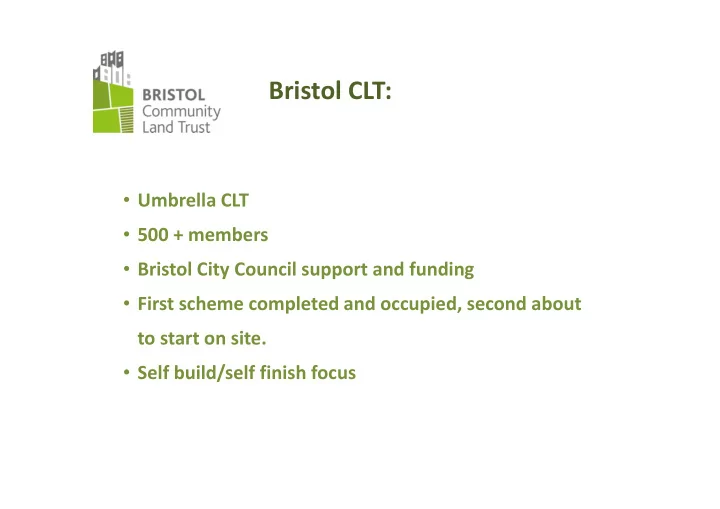

Bristol CLT: • Umbrella CLT • 500 + members • Bristol City Council support and funding • First scheme completed and occupied, second about to start on site. • Self build/self finish focus
First project at Fishponds Road
Fishponds Road Financial Model: � Debt repaid by rent – PLUS � Homes and Communities Agency grant � Bristol City Council support � ‘free’ land � Element of self finish � Equity contributions from some residents (7 out of total of 12)
Converting former school building to studios c
Constructing terrace of 3 – bedroom family houses
Self Finish Programme • Self Finish Group made up of future residents • Self Finish Group Manager appointed • Schedule of self finish work includes: fitting kitchens and bathrooms, decorating, communal garden, bike shed, cycle shed • Scheduled items omitted from the main contract and set aside as a ‘sweat equity’ fund.
c Self Finish Programme: Future residents complete their homes
Future residents plan landscaping with support of architecture students….
…and then construct landscaping works after move-in.
The project as it is today…
Shaldon Road: New site for 49 houses
We began by consulting existing residents around the site
Shaldon Road: Planning Permission Granted
Shaldon Road: Planning Permission Granted
Shaldon Road: Planning Permission Granted
After completing the Fishponds project, we held a conference
And we wrote a community–led housing policy for our local authority authority Planning and POLICY CLH2: Using planning policy and the planning system to Design influence and support the CLH sector and delivery of CLH schemes The Bristol Local Plan will be reviewed in 2018. BCC should use this opportunity to review planning and design policies to better support the CLH sector. The local authority should consider: Allocating a planning officer to work with the CLH sector Using the site allocation process to identify specific sites for community led housing Reviewing new GLA CLH planning policies to see if any would work for Bristol Supporting communities to develop community led housing policies within their Neighborhood Plans Developing an urban alternative to the rural exception site policy Introducing policies for the inclusion of community led housing and self- build provision in proposals for large sites Establishing a light touch procedure for small sites and small groups which provides flexibility for CLH schemes (space standards, density, vehicle numbers) where the community supports the scheme Ensure that the design of CLH schemes meet best practice for inclusion of accessibility and health and well-being measures Working with the CLH sector to consider other planning policy instruments that could promote long term stewardship of land by communities.
Strength of the CLT model • Builds communities not housing estates • Removes land from the market • Access for community-defined purposes at costs based on use value rather than asset value • Hosts residential and non-residential activities • Supports non-professionals during high risk development phase
Keith Cowling Bristol CLT Chair keith@eyehouse.info www.bristolclt.org.uk www.facebook.com/bristolclt www.twitter.com/bristolclt
Recommend
More recommend